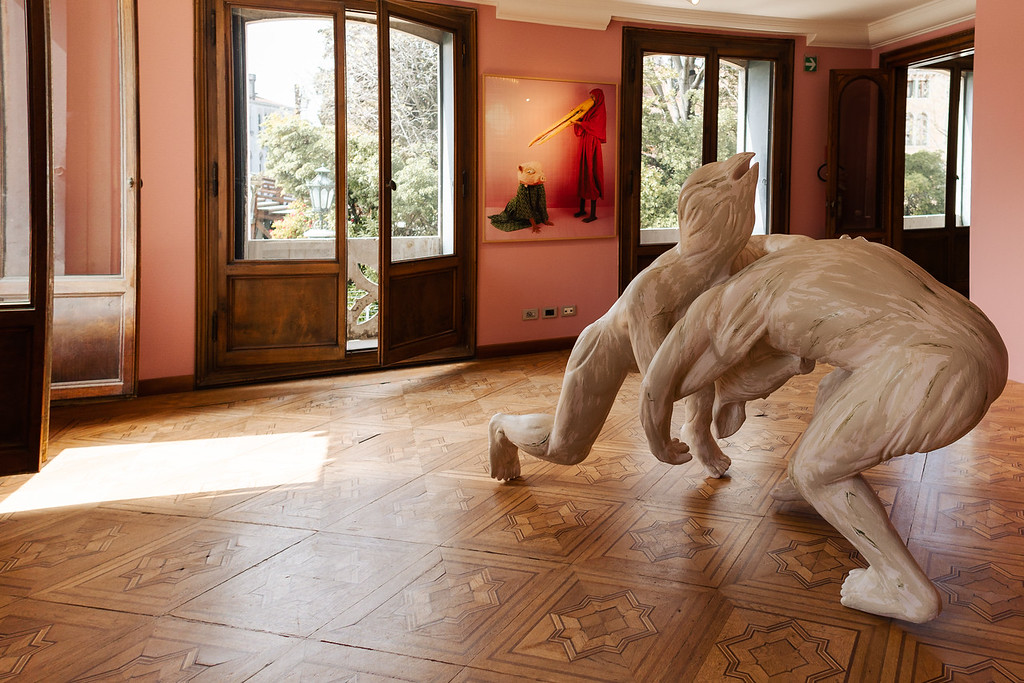



 Share the love —
Share the love —
From the comfort of her grass green velvet sofa, Maitha Abdalla looks out towards Abu Dhabi’s central business district. Her studio space is a testimony to the diversity within her practice. A paper-mâché pig’s head, unpublished poems, and small sculptural works, assembled from discarded materials fight for surface space. On the wall, a floor-to-ceiling work on paper is invested with a swirling pastel palette and smudged with the trace of the artist’s fingertips in charcoal dust.
The Emirati artist has accomplished a lot in just one year. Off the back of two solo shows in Dubai and London, it was recently announced that she will participate in the Sharjah Biennial 2023. We caught up with her amid a fleeting few days in the UAE upon her return from the Venice Biennial.
The body of work exhibited by Abu Dhabi Art in Venice, “Too Close To The Sun,” was inspired by the “wild nature” of women that social forces have attempted to tame. For this series, Maitha found a kindred spirit in American psychoanalyst, Clarissa Pinkola Estes, a woman who established her own feminine mythologies and wrote: “Within every woman, there is a wild and natural creature, a powerful force, filled with good instincts, passionate creativity, and ageless knowing. Her name is Wild Woman, but she is an endangered species.”
Maitha’s artistic language operates between fantasy and reality; the contrived and fantastical realm of the theater became a space where she could navigate that which she’d encountered in her social world, her imaginations, memories and fantasies at a distance. Maitha’s art takes on multiple forms – film and photography, sculpture, works on canvas and performance – all in dialogue with one another.
The artist merges banal domestic spaces – bedrooms and bathrooms – with the seductive glamor of the theatrical stage, a universe to which she defers her inner concerns. “Hollowed” (2019), for example, unraveled the feeling of ‘hollowness’ that overshadowed Maitha; a feeling that she perceives in multiple forms: emptiness, memory, wasting and re-birth.
Set in a surreal, deconstructed theatrical environment, “Hollowed” combined performance video and sculptural works in a two part-performance piece. In the video, Maitha ushered her audience through a thick, red velvet curtain into a space where they might contemplate hollowness.
In her performance, Maitha attempts metamorphosis. Through the process of finding herself inside various fabrics and materials, she hoped to become something new, however, she failed and remained hollow. She then crawled from this sequence, leading the viewers into an eerie space where they might encounter her “Re-Birth” installations, fantastical anthropomorphic creatures that summon hollowness in all forms.
Her art forms an ongoing investigation into the self. Maitha understands herself as multifaceted and ever-shifting, as such the characters that contribute to her scenes often embody a distinct vector of her personality: “The pig, a motif of sin, and the rooster, an icon of purity, regularly occur in my practice but I also produce grotesque hybrid, creatures that exist between the human and animal worlds. These animorphs are the physical manifestation of an idea, passed on to me in childhood, that our habits and practices ‘become us’,” says Maitha.
“My art offers an opportunity to present conflicting and co-existing aspects of myself. Each character represents a piece of me,” she says. “On the surface, they might appear in pain or fighting one another for visibility yet there is a sense of intimacy and inter-dependency that I hope to capture among them.”
It’s art that explores the gap between inner feelings and outward actions. Socially constructed notions of right/wrong, sin/purity unfold throughout much of Maitha’s work. In her youth, the community around her came to establish and reinforce these value systems but through travel, Maitha came to realize that what constitutes right and wrong, good and bad, is contextually dependent and therefore up for interrogation.
“You cannot unlearn what you’ve been taught,” says Maitha. “But you can understand it anew. Being ‘wrong’ and the fear of being sinful carry weight. My art is one way for me to rethink the constructs that were instilled in me in my youth, there are parallels between the construction of social ideas and theatrical performance. People are performative both on and off the stage,” she suggests.
Is Maitha attempting to establish a correcting lens through her art? She addresses concerns that others might shy away from and is, as such, regularly quizzed about whether she’s compelled to challenge conventions or upturn certain stereotypes surrounding Emirati women and Arab women more broadly. Instead, she problematizes art based on cultural specificities.
“Creating art that destabilizes cultural stereotypes isn’t of keen concern,” she remarks. “My art speaks from a deeply intimate place. Sure, my lived experiences come from a specific context, but I’m an artist dealing with my own subjectivities first and foremost. I’m not motivated to produce art that engages with limiting narratives, by entering into a dialogue with them you afford them a sense of validity.”